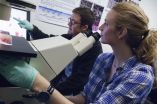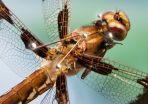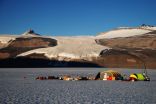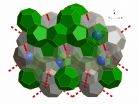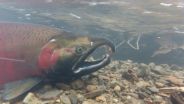(Press-News.org) CORVALLIS, Ore. - Researchers for the first time have developed a method to track through the human body the movement of polycyclic aromatic hydrocarbons, or PAHs, as extraordinarily tiny amounts of these potential carcinogens are biologically processed and eliminated.
PAHs, which are the product of the incomplete combustion of carbon, have been a part of everyday human life since cave dwellers first roasted meat on an open fire. More sophisticated forms of exposure now range from smoked cheese to automobile air pollution, cigarettes, a ham sandwich and public drinking water. PAHs are part of the food we eat, the air we breathe and the water we drink.
However, these same compounds have gained increasing interest and scientific study in recent years due to their role as carcinogens. PAHs or PAH mixtures have been named as three of the top 10 chemicals of concern by the Agency for Toxic Substances Disease Registry.
With this new technology, scientists have an opportunity to study, in a way never before possible, potential cancer-causing compounds as they move through the human body. The findings were just published by researchers from Oregon State University and other institutions in Chemical Research in Toxicology, in work supported by the National Institute of Environmental Health Sciences (NIEHS)
The pioneering work has been the focus of Ph.D. research by Erin Madeen at Oregon State, whose studies were supported in part by an award from the Superfund Research Program at NIEHS for her work at Lawrence Livermore National Laboratory.
"We've proven that this technology will work, and it's going to change the way we're able to study carcinogenic PAHs," said David Williams, director of the Superfund Research Program at OSU, a professor in the College of Agricultural Sciences and principal investigator with the Linus Pauling Institute.
"Almost everything we know so far about PAH toxicity is based on giving animals high doses of the compounds and then seeing what happens," Williams said. "No one before this has ever been able to study these probable carcinogens at normal dietary levels and then see how they move through the body and are changed by various biological processes."
The technology allowing this to happen is a new application of accelerator mass spectrometry, which as a biological tracking tool is extraordinarily more sensitive than something like radioactivity measuring. Scientists can measure PAH levels in blood down to infinitesimal ratios - comparable to a single drop of water in 4,000 Olympic swimming pools, or to a one-inch increment on a 3-billion mile measuring tape.
As a result, microdoses of a compound, even less than one might find in a normal diet or environmental exposure, can be traced as they are processed by humans. The implications are profound.
"Knowing how people metabolize PAHs may verify a number of animal and cell studies, as well as provide a better understanding of how PAHs work, identifying their mechanism or mechanisms of action," said Bill Suk, director of the NIEHS Superfund Research Program.
One PAH compound studied in this research, dibenzo (def,p)-chrysene, is fairly potent and defined as a probable human carcinogen. It was administered to volunteers in the study in a capsule equivalent to the level of PAH found in a 5-ounce serving of smoked meat, which provided about 28 percent of the average daily dietary PAH intake. There was a fairly rapid takeup of the compound, reaching a peak metabolic level within about two hours, and then rapid elimination. The researchers were able to study not only the parent compound but also individual metabolites as it was changed.
"Part of what's so interesting is that we're able to administer possible carcinogens to people in scientific research and then study the results," Williams said. "By conventional scientific ethics, that simply would not be allowed. But from a different perspective, we're not giving these people toxins, we're giving them dinner. That's how much PAHs are a part of our everyday lives, and for once we're able to study these compounds at normal levels of human exposure."
What a scientist might see as a carcinogen, in other words, is what most of us would see as a nice grilled steak. There are many unexpected forms of PAH exposure. The compounds are found in polluted air, cigarettes, and smoked food, of course, but also in cereal grains, potatoes and at surprisingly high levels in leafy green vegetables.
"It's clear from our research that PAHs can be toxic, but it's also clear that there's more to the equation than just the source of the PAH," Williams said. "We get most of the more toxic PAHs from our food, rather than inhalation. And some fairly high doses can come from foods like leafy vegetables that we know to be healthy. That's why we need a better understanding of what's going on in the human body as these compounds are processed."
The Williams-led OSU laboratory is recruiting volunteers for a follow-up study that will also employ smoked salmon as a source of a PAH mixture and relate results to an individual's genetic makeup.
Some of the early findings from the study actually back up previous research fairly well, Williams said, which was done with high-dose studies in laboratory animals. It's possible, he said, that exposure to dietary PAHs over a lifetime may turn out to be less of a health risk that previously believed at normal levels of exposure, but more work will need to be done with this technology before such conclusions could be reached.
INFORMATION:
Collaborators on the study were from the Pacific Northwest National Laboratory, Lawrence Livermore National Laboratory, and the OSU Environmental Health Sciences Center.
"Further development and application of this technology could have a major impact in the arena of human environmental health," the researchers wrote in their conclusion.
Many children who sustain so-called open bone fractures in the forearm or lower leg can, and do, heal safely without surgery, according to the results of a small study led by investigators at the Johns Hopkins Children's Center.
Open fractures occur when the broken bone protrudes through the skin, causing a puncture wound.
The study, published ahead of print in the Journal of Children's Orthopaedics, shows that when the wound is small -- less ½-inch in diameter -- and the surrounding tissue is free of visible contamination with dirt or debris, children heal well ...
CAMBRIDGE, MA, December 10, 2014 - A team of investigators from the Broad Institute, Massachusetts General Hospital and other leading biomedical research institutions has pinpointed rare mutations in a gene called APOA5 that increase a person's risk of having a heart attack early in life. These mutations disable the APOA5 gene and also raise the levels in the blood of triglyceride-rich lipoproteins, a type of fat. The researchers' findings, together with other recent genetic discoveries -- specifically, the identification of protective mutations in the APOC3 gene that lower ...
Stem cells in early embryos have unlimited potential; they can become any type of cell, and researchers hope to one day harness this rejuvenating power to heal disease and injury. To do so, they must, among other things, figure out how to reliably arrest stem cells in a Peter Pan-like state of indefinite youth and potential. It's clear the right environment can help accomplish this, acting as a sort of Neverland for stem cells. Only now are scientists beginning to understand how.
New collaborative research between scientists at Rockefeller University and Memorial ...
The dragonfly is a swift and efficient hunter. Once it spots its prey, it takes about half a second to swoop beneath an unsuspecting insect and snatch it from the air. Scientists at the Howard Hughes Medical Institute's Janelia Research Campus have used motion-capture techniques to track the details of that chase, and found that a dragonfly's movement is guided by internal models of its own body and the anticipated movement of its prey. Similar internal models are used to guide behavior in humans.
"This highlights the role that internal models play in letting these creatures ...
INDIANAPOLIS -- How do some proteins survive the extreme heat generated when they catalyze reactions that can happen as many as a million times per second? Work by researchers from Indiana University-Purdue University Indianapolis (IUPUI) and the University of California Berkeley published online on Dec. 10 in Nature provides an explosive answer to this important question.
Proteins are essential to the human body, doing the bulk of the work within cells. Proteins are large molecules responsible for the structure, function, and regulation of tissues and organs. Enzymes ...
CORVALLIS, Ore. - Nitrous oxide (N2O) is an important greenhouse gas that doesn't receive as much notoriety as carbon dioxide or methane, but a new study confirms that atmospheric levels of N2O rose significantly as the Earth came out of the last ice age and addresses the cause.
An international team of scientists analyzed air extracted from bubbles enclosed in ancient polar ice from Taylor Glacier in Antarctica, allowing for the reconstruction of the past atmospheric composition. The analysis documented a 30 percent increase in atmospheric nitrous oxide concentrations ...
In a ground-breaking paper published in Nature, they show that the three protein complexes act in relay to regulate cell division: reactivation of one leads to the second becoming active.
Cells rely on control systems to make sure that each aspect of the cell division cycle occurs in the correct order. Following successful segregation of the genomes in mitosis, each must return to its pre-division state in a process called mitotic exit. Mitotic exit is irreversible for all multicellular organisms. Loss of cell cycle control during this process - leading to unregulated ...
Clathrates are now known to store enormous quantities of methane and other gases in the permafrost as well as in vast sediment layers hundreds of metres deep at the bottom of the ocean floor. Their potential decomposition could therefore have significant consequences for our planet, making an improved understanding of their properties a key priority.
In a paper published in Nature this week, scientists from the University of Göttingen and the Institut Laue Langevin (ILL) report on the first empty clathrate of this type, consisting of a framework of water molecules ...
CAMBRIDGE, MA -- Using a gene-editing system originally developed to delete specific genes, MIT researchers have now shown that they can reliably turn on any gene of their choosing in living cells.
This new application for the CRISPR/Cas9 gene-editing system should allow scientists to more easily determine the function of individual genes, according to Feng Zhang, the W.M. Keck Career Development Professor in Biomedical Engineering in MIT's Departments of Brain and Cognitive Sciences and Biological Engineering, and a member of the Broad Institute and MIT's McGovern Institute ...
Anticipated changes in climate will push West Coast marine species from sharks to salmon northward an average of 30 kilometers per decade, shaking up fish communities and shifting fishing grounds, according to a new study published in Progress in Oceanography.
The study suggests that shifting species will likely move into the habitats of other marine life to the north, especially in the Gulf of Alaska and Bering Sea. Some will simultaneously disappear from areas at the southern end of their ranges, especially off Oregon and California.
"As the climate warms, the species ...

